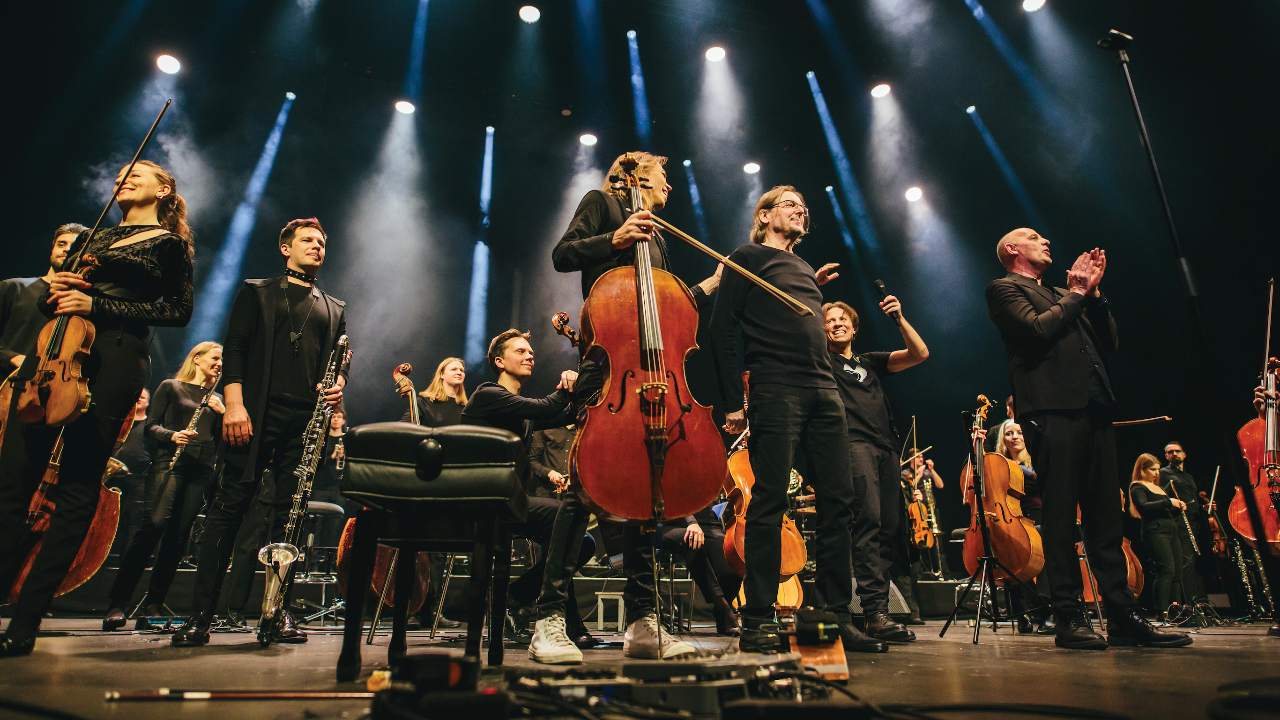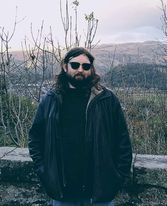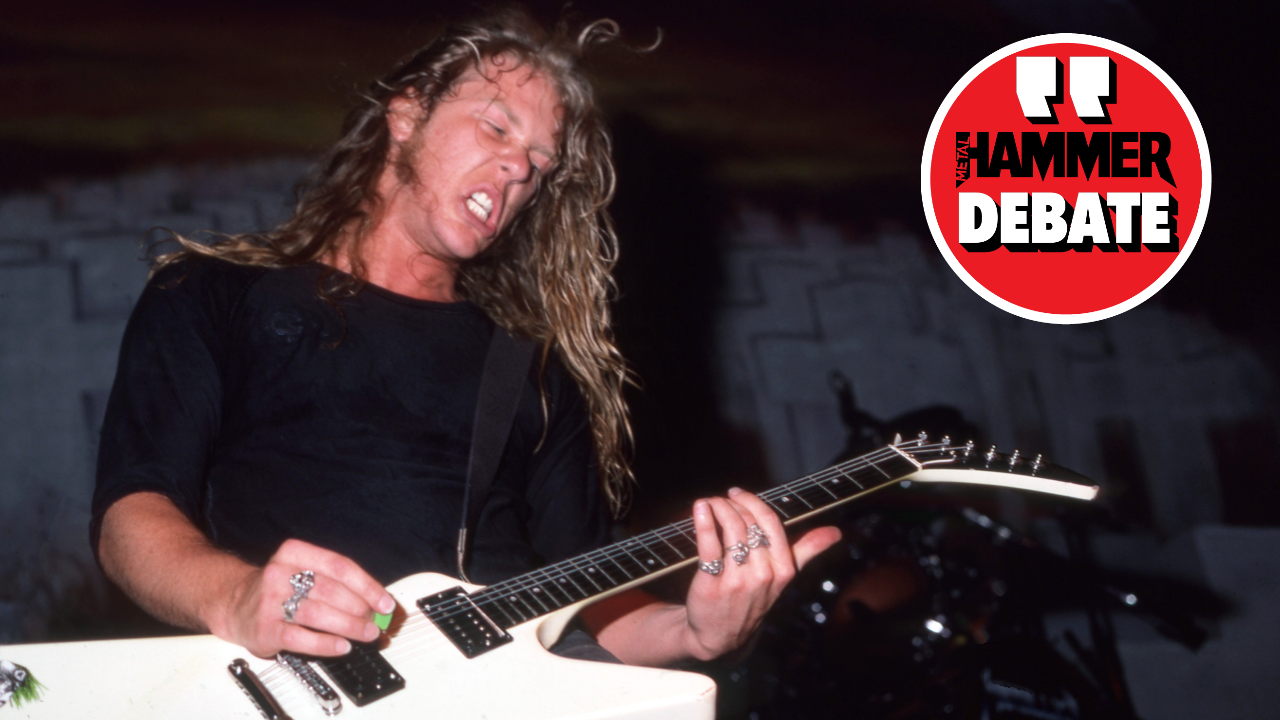What happens when members of extreme metal royalty like Meshuggah, Watain and Opeth form an orchestra? Meet the uniquely excellent Bright & Black
Bright & Black have made one of this year's most compelling albums. We found out how it all came together

In a dark room, an orchestra strikes up. Violins play a staccato melody, and as more instruments join – a horn here, a crash of drums there – blue lights overhead cast an eerie glow. By the time the music hits a triumphant crescendo, the room is finally illuminated enough to make out the crowd. There’s an expected mix of evening dresses, ball gowns, suits and tuxedos, but it’s the smattering of Meshuggah, Opeth and other miscellaneous metal shirts that give the biggest hint this isn’t your average classical concert.
We’re at the Alexela Concert Hall in Tallinn, the capital city of Estonia, for the first-ever performance by Bright & Black. The band are the brainchild of Jacob Hellner – best known for producing the first six Rammstein albums – and artist manager/former A&R rep Per Kviman. For 20 years, the Swedes had been discussing an idea: what if they asked well-known Scandinavian metal artists to compose original pieces of music, which would be performed by an orchestra?
They put their plan into motion in 2018, and Bright & Black’s debut record was released in January of this year. Plainly titled The Album, it features contributions from Meshuggah’s Tomas Haake and Dick Lövgren, Opeth guitarist Fredrik Åkesson, Watain frontman Erik Danielsson and Entombed AD guitarist Nico Elgstrand – that’s one hell of a pedigree.
When we meet Jacob the day before the show, his mood is teetering between nervous excitement and fatigue, following a gruelling week of nonstop rehearsals. “It’s been intense,” he admits with a chuckle, as we sit in the bar of the Nordic Forum Hotel near the venue, alongside his musical co-conspirators – more on them later. “I’ve had the opportunity to record strings for pop and metal tracks a couple of times, and it’s always been super-exciting. At the same time, I didn’t want anyone putting on a wig and pulling out their goose feather quills – I wanted it to be authentic.”
Enter: Eicca Toppinen. As the leader of Apocalyptica, the Finns who found fame in 1996 with the release of their debut album, Plays Metallica By Four Cellos, he’s as comfortable in the classical world as the metal one. He wrote Bright & Black track Collateral Damage, and is the group’s soloist. “Eicca was the only person on the planet who could possibly front a thing like this,” Jacob admits. “I first saw Apocalyptica opening for Rammstein when we made [2005’s] Live At Brixton Academy and I was blown away.”
“Jacob must have approached me five or six years ago,” Eicca recalls. Although front-and-centre of the group, Eicca isn’t suffering any pre-show jitters. In fact, other than his long blond hair being windswept and a slight rosiness to his cheeks from dashing across from the Alexela Concert Hall, he exudes a sense of calm, collected cool.
“I’m just here to communicate between metal and classical tradition,” he explains. “The orchestra make the magic.” The 40-piece Baltic Sea Philharmonic were founded by Estonia-born conductor Kristjan Järvi in 2008, and their work reinterpreting orchestral music through a contemporary lens has made him something of a rock star in the classical world. Exuberant and charismatic, he is an affable motormouth in the vein of a Corey Taylor or Benji Webbe. Unlike other conductors, who stand rooted with a baton, Kristjan prefers to lead from amid his players, more akin to a hype man ensuring everybody remains on-point.
Sign up below to get the latest from Metal Hammer, plus exclusive special offers, direct to your inbox!
“We aren’t an orchestra playing metal, we’re a band that play orchestral instruments,” he says, before leaning in conspiratorially. “Would you like to meet the band?” Standing up, he calls for the BSP to say hello, and the room turns as one to greet us, like a scene straight out of John Wick. As Kristjan settles back down at the table, a mischievous grin plastered across his face, we get the sense that his maverick status in the classical world applies to more than just music.
“I’ve seen a lot of institutional orchestras,” he says with an air of dismissiveness. “You get the sense that these people really want to do something unique and different, but can’t because they’re in glass boxes. We’re breaking those boxes.”

Be metal, not plastic! The snare drum needs to be nastier! Give me a blastbeat!” It’s 3pm the next day, and we’re at the final rehearsal for tonight’s show. Kristjan is pacing the stage like a drill sergeant, making final adjustments. Although Jacob won’t be performing, he’s still feeling the pressure, recounting how a live show can transform an audience’s perception of music. He should know – he almost passed on working with Rammstein until he saw them play.
“The Rammstein demos were pretty crap,” he recalls. “But they had a clear vision of what they wanted to do. Rammstein in 1994 were basically doing the same thing they do now – just on a smaller scale. You need conviction; failure simply isn’t an option.”
Metal’s flirtations with classical music are well documented. But while something like Metallica’s team-up with conductor Michael Kamen and the San Francisco Symphony on S&M, or even Eicca’s work in Apocalyptica might seem like obvious reference points, Bright & Black’s path hasn’t been so linear.
“S&M worked because Michael Kamen knew Metallica and had worked with them, so he knew exactly what he was doing when he made the arrangements,” Kristjan says. “But he also knew it was basically a PR stunt. S&M opened a door, but not many bands have gone through.”
Bright & Black’s first outing, The Album, combines classical music’s grandeur and epic scale with the disorienting force and power of extreme metal. Tracks such as Bloodgrind and Armies Of The Preposterous offer orchestral blastbeats and tooth-gnashing extremity in the realms of black metal, while the likes of Nidhugg and Eric Danielsson’s Mounts Of Misfortune explore a more elegiac, almost gothic sensibility.
“For The Album, everyone had their own way of writing,” Jacob explains. “Erik wrote everything on guitars that were super-distorted, with shitloads of reverb, and then that’s what he gave us. Nico found an orchestra library and basically experimented with things, and that’s how Bloodgrind came about. Fredrik wrote Nidhugg on guitar, and then Nico and I translated it for the orchestra.”
One person who isn’t struggling to get into the metal headspace today is Eicca. His enthusiasm is infectious, and he headbangs while he plays. “I had to get all-new cello strings – I’ve worn mine out before we’ve even played a show!” he admits as he comes offstage. “It’s blown me away just how much power and magic there is.”
He also admits he got a positive sign from above after Bright & Black’s first rehearsal together in Tallinn. Stepping outside the studio, he looked up and saw the Northern Lights dancing overhead, bathing the sky in hues of green.
“That literally never happens,” he enthuses. “They were so intense and beautiful, and that’s given me confidence that we shouldn’t acknowledge anything less than universal acceptance.”
For Kristjan, too, the performance has a deep significance. In 1988, during the Song Festival – a traditional event held every five years in Tallinn – Estonians sang national songs in defiance of the Soviet forces then occupying the country. It kicked off a series of events called the ‘Singing Revolution’, that saw them declare independence in 1991. “We literally sang and danced ourselves into a country,” he says with a chuckle. “But even now, it’s really fragile. We thirst for life, not for comfort.”

The Alexela Concert Hall is an oddity. Opened in 2009, the 1,829-capacity venue’s tinted-glass exterior and wooden-panelled interior are a stark contrast to the maze of cobbled streets, subterranean bars and mediaeval- style taverns that make up the rest of the historical Old Town of Tallinn. But in its own way, the Alexela Concert Hall is making history.
The streets are largely deserted before showtime, and with temperatures dipping below freezing, Hammer is forced to duck into one of the taverns. Goblets of Glögg – Estonian mulled wine – are gratefully glugged, though we aren’t brave enough to try the bear stew. But as doors open at the Alexela, the city comes alive and punters swarm in.
Backstage, the Bright & Black orchestra are getting ready. Spiked necklaces and studded wristbands are broken out, while black eyeliner and nail polish are liberally shared. One musician wanders past asking if anyone knows how to apply corpsepaint. “They really want to look the part,” Jacob explains sympathetically.
As showtime nears, Hammer finds our seats. From utter darkness, Nidhugg springs to life with jutting strings and propulsive instrumental swells. Drums clatter with calamitous force while Kristjan paces, hammering along on a traditional Norse shaman drum. During Bloodgrind, Eicca strikes a bow across his cello like he’s trying to saw it in half. It’s gorgeous, dramatic and undeniably metal, the audience torn between a polite but rapt attentiveness, while some appear to be doing the headbanging equivalent of a whisper, furiously nodding along to each new composition.
“This is the biggest metal band you’ll ever see onstage,” Kristjan quips, before the crowd stand and clap along to closer And Flesh And Blood. Its insistent beat is met with increasingly frenzied instrumentation, as Kristjan encourages the musicians to go as hard as they possibly can for a massive – and delightfully noisy – crescendo. And then, it’s over. Downstairs, Hammer gauges the reactions from audience members. There’s a diverse spread of ages and musical tastes – there are even families waiting in line to grab merch – but the overwhelming consensus is that Bright & Black are brilliant.
“We just love Kristjan Järvi,” enthuses Tallinn resident Caira, who’s come with her husband, Daron, and is happily brandishing a vinyl copy of The Album. “That was a deal- maker for us. Everything he does is so exciting and fresh, and tonight was something completely different to what he’s done before – we loved it.”
Nervousness banished, Jacob Hellner is beaming. Bright & Black have more shows booked for Stockholm, Berlin and Hong Kong, but then... what next? Is this a one-and- done thing, or will we hear more collaborations from the gang in future?
“I have no idea where this project is going to take us,” Jacob admits. “Two years ago, I wouldn’t have believed you if you told me we were going to play a show, let alone a tour. But if we ever do a follow-up album, I’ll tell you this – it won’t be the same.”
For now, the band are basking in tonight’s achievement – of bringing genres together and coming up with a truly powerful experience. “Metal is an attitude,” says a still-wired Kristjan. “It’s an illusion that Beethoven is not metal. Beethoven is metal, Berlioz is metal, Stravinsky is metal... it’s an attitude that comes from self-trust and confidence, and we’ve nailed it.
Staff writer for Metal Hammer, Rich has never met a feature he didn't fancy, which is just as well when it comes to covering everything rock, punk and metal for both print and online, be it legendary events like Rock In Rio or Clash Of The Titans or seeking out exciting new bands like Nine Treasures, Jinjer and Sleep Token.

